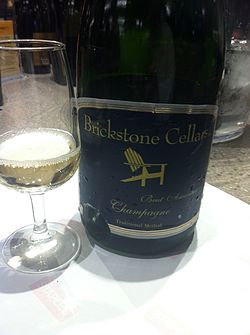New York wine
New York wine refers to wine made from grapes grown in the U.S. state of New York. New York ranks third in grape production by volume after California and Washington. Eighty-three percent of New York's grape area is Vitis labrusca varieties (mostly Concord). The rest is split almost equally between Vitis vinifera and French hybrids.
New York State's wine production began in the 17th century with Dutch and Huguenot plantings in the Hudson Valley region. Commercial production did not begin until the 19th century. New York is home to the first bonded winery in the United States of America, Pleasant Valley Wine Company, located in Hammondsport. It is also home to America's oldest continuously operating winery, Brotherhood Winery in the Hudson Valley, which has been making wine for almost 175 years. Furthermore, New York State is home to North America's oldest dedicated sacramental winery, O-Neh-Da Vineyard, now operated by Eagle Crest Vineyards on Hemlock Lake in the Western Finger Lakes region.
In 1951 Dr. Konstantin Frank emigrated from the Ukraine to New York, to work at Cornell University’s Geneva Experiment Station. Frank was hired by Cornell as a janitor at the Geneva Experiment Station. Though he was a respected viticulturalist in Ukraine, this was the only position for which his American work experience, which consisted of his being a janitor at Horn & Hardart's cafeteria in New York, qualified him at the time. He spent his spare time at Cornell attempting to convince his colleagues that the failures of quality wine production in New York had to do with their choice of vines. He believed that choosing the correct Vitis vinifera vines would yield great wines in the Finger Lakes. With three-hundred years of failure preceding his theory, his colleagues were skeptical. Combined with a language barrier (although Dr. Frank spoke six languages fluently, English was not one of them) his vision would have to wait for an appropriate ear.
...
Wikipedia

